Transcription of Social Pedagogy in the Classroom - SPPA UK
1 20313 Social Pedagogy in the ClassroomSupporting Children and Young People in CareEMMA BLACK, MICHAEL BETTENCOURT AND CLAIRE CAMERONThe hypothesis at the heart of this chapter is that you, the target reader of this book, have chosen to enter the teaching profession for a specific reason: you want to make a difference to the lives of the children and young people in your fellow professionals in the education sector, we recognise that demands such as implementing a high stakes accountability-driven curriculum can, without careful consideration, be to the detriment of supporting the emotional needs of the children and young people in your care. Drawing on the work of Cameron, Connelly and Jackson s (2015) Educating Children and Young People in Care: Learning Placements and Caring Schools, we argue that for children to thrive and flourish, the integration of care and education in daily life is key.
2 We believe this is particularly pertinent to those children and young people who have experienced difficult childhoods. As such, it is these children who are the focus of this chapter. In an effort to support you in establishing and maintaining the synergy between care and education, we present the field of Social Pedagogy for your and young people in careAs Chapter 12 has confirmed, the legal term for children and young people in care is looked-after children (or LAC). These children and young people have been separated from their birth families often for their own safety and placed into the care of the local authority. They are considered one of the most vulnerable groups of children ATTACHMENT AND EMOTIONAL development IN THE CLASSROOM204and young people in society, particularly when they first come into care. Most of these children and young people live in foster care and some live with extended family, while others are placed in residential children s homes.
3 Many children and young people in care live in a state of flux, moving from placement to placement for reasons beyond their control. In contrast, however, a significant number are able to live in long-term placements, establish and maintain healthy relationships, perform well at school and describe feeling safe and children and young people in care are bound by a legal status,1 they are not a homogenous group. That said, it is important to note that they usually share common traumatic experiences relating to separation, neglect, abuse and loss. Children and young people in care have often been subject to multiple forms of distressing events over a long period of time. Cairns (2013) explains that when placed in these situations, our bodies produce a toxic level of stress hormone (cortisol). This survival response has the power to influence our physical, psychological and Social ways of functioning such as our ability to coordinate our body, focus on presented tasks, relate positively to ourselves and the world around us and to form relationships with others.
4 Supporting children and young people through these difficulties is by no means an easy feat. We propose that Social Pedagogy in the Classroom not only acts as a springboard to recovery for those who have experienced trauma, but also provides a context for establishing and maintaining the synergy between care and education for all children and young people in your Pedagogy in the classroomIn many continental European countries, Social Pedagogy is considered both a profession and a discipline (Bennett and Tayler 2006; Petrie et al. 2009). It can be traced back to the work of educational philosophers such as Rousseau, Pestalozzi and Frobel. It has influenced a range of children s services and organisations such as teacher education, youth work, early childhood education, community education and Social work (Cameron et al. 2011a). In the UK, Social Pedagogy is becoming an increasingly familiar term in educational policy and 1 For a detailed analysis of legislation surrounding the education of children and young people in care, see Cameron et al.
5 (2015, 42).205 Social Pedagogy IN THE Classroom reform. Over 2000 care, education and related practitioners have attended Social Pedagogy short courses in the UK since 2009. Under the previous Labour government, Petrie et al. (2009) argued that the Social pedagogic approach was well suited to English policy concerns relating to how society best served its children and young people. The recent changes made to the Special Educational Needs and Disability (SEND) Code of Practice (2015), which emphasises person-centred practice, have highlighted an ideal context for this plea, once again. In practice, Social Pedagogy is considered a dynamic, humanistic approach to education that takes account of, but goes beyond, subject learning (Kyriacou et al. 2009). Humanism, as outlined in Chapter 1, focuses on developing human potential through relationships, wellbeing and happiness, holistic learning and empowerment (Eichsteller and Holthoff 2012).
6 To demonstrate what this might look like in your Classroom , we present some distinctive features of a Social pedagogical approach Classroom teacher as a Social pedagogueIt would be a mistake to consider Social Pedagogy as reducible to a collection of techniques. Instead, it is helpful to consider it as an art form that connects the teacher to their fundamental values and beliefs. Cameron et al. (2011, 16) provide a helpful summary of a Social pedagogical approach which, for the purposes of this chapter, have been rearranged to provide a useful insight into what it might look like in your Classroom . Cameron et al. (2011) suggest that Social pedagogues: Focus on the child as a whole person. They recognise that children are immersed in a complex relational system of support. They are aware that children and young people think, feel, have a physical, spiritual, Social and creative existence, and that all of these characteristics continually interact in unison.
7 Similarly they bring themselves as a whole person to their work. Constantly reflect on their practice. To overcome the challenging demands they are often confronted with, they draw on and apply theoretical understandings to their everyday practice (Petrie et al. 2009). They make decisions ATTACHMENT AND EMOTIONAL development IN THE CLASSROOM206about moving forward according to the best interests of the children and young people in their care. Bring their hearts to their work as ethical and emotional beings. They are connected to their fundamental values and beliefs and are constantly aware of how these express themselves in the outer world (Eichsteller and Holthoff 2012). They are aware of how their own emotional reactions can affect their relationships and communications with children and others.
8 Through their relationships with other people they show empathy and respect. They value, listen to and respond to the point of view of others, knowing that this will often be different from their own. Are both practical and creative. Simple activities that make up the many aspects of children s daily lives, such as preparing meals and snacks, or making music and building kites, are viewed as a medium for building safe trusting relationships (Petrie et al. 2006). Share their space. While they are together, children and adults are seen as inhabiting the same life space, not as existing in separate, hierarchical domains (Petrie et al. 2009). Value teamwork. They actively seek the contribution of other people in supporting children and young people. In doing so they form good working relationships with parents and carers, other professionals and members of the local that we have briefly introduced you to Social Pedagogy and how this might influence you as a beginning teacher, our focus turns to how you can use this approach to establish and maintain the synergy between care and education in your Classroom .
9 We present to you what is often referred to as the head, heart and hands triad of Social pedagogical the head, heart and hands of your practiceThe humanistic nature of Social Pedagogy is often encapsulated in the expression head, heart, hands (Eichsteller and Holthoff 2012). This phrase was first coined by Johann Heinrich Pestalozzi, a Swiss 207 Social Pedagogy IN THE Classroom educational reformer, in the late 18th century, to demonstrate how the whole person is involved in the art of teaching. Pestalozzi believed that the spirit of teaching came to light through the interaction of these three elements (Soertard 1994). From a Social pedagogical perspective, the synergy of care and education in the Classroom can be established and maintained through an art of being with children as opposed to doing . In this way, the focus of practice is directed toward: The values and beliefs you hold relating to education (Head).
10 How you express these values and beliefs (Heart). Activities that form part of your everyday practice (Hands).Exploring these elements in more detail provides a useful framework to explain how we believe the Social pedagogical approach can support you to establish and maintain the synergy of care and education in your : The values and beliefs you hold relating to educationIn Radical Education and the Common School, Fielding and Moss (2010)[AQ] explore the influential works of Loris Malaguzzi, founder of the Reggio Emilia approach, and his successor Carlina Rinaldi, a leading pedagogical thinker. Through this exploration, two fundamental questions relating to the values and beliefs you hold about education emerge: (1) What is your theory of learning? (2) What is your image of the child ?It is important to note the significance of these questions as your answers will inevitably shape and inform every aspect of your practice.









